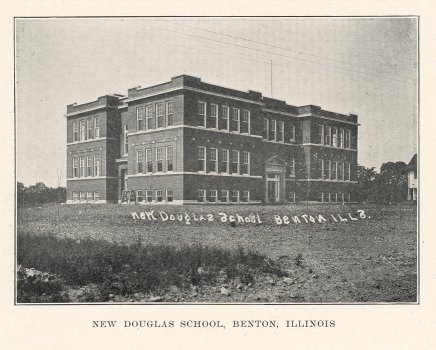
Pg 92
improvement, this contained the hotel and postoffice, and was destroyed by fire. The new McCreery block sprang up in its place. The Webster building off the old Webster lot on west side of square was the latest on the square. The building now being erected by the First National Bank will be the climax of all the buildings to date. The building is to be six stories high, with elevator service.
Pg 93
Browning Township lies east of Tyrone and south of Barren. It was settled first on Browning Hill in 1814 by John Browning and others. John Browning lived at the Jordan Fort for a while, and two of his sons, James K. and William R. were born in the fort in 1810 and were the first white children born in Franklin County. The oldest house now standing is on Browning Hill and was built in 1814. The Kings, Jones, Harrisons, and Hutsons settled around Browning Hill. There were numerous springs in the vicinity of the Browning Hill so this settlement became known as the Spring Settlement. John Browning was doubtless the first Baptist preacher in the county. Through his efforts the Mount Pleasant Baptist Church was organized in 1829 which was the first Baptist church organized in the county.
The name of the township, like Goode, and Denning, took its name from the family of early settlers.
The Big Muddy River flows through the township, thereby making a large area non-productive.
Buckner on the Illinois Central R. R. is a thriving town of about twenty-five hundred people. From the time the railroad was built till 1906 not much business was done at this place, but a coal mine was located east of Buckner which furnishes employment for several hundred men, since then the town has made rapid strides in its growth.
Rend City was established about three miles north of Buckner when the W. P. Rend Coal Co. located their mine there. A spur from the Chicago, Burlington & Quincy R. R. was built out to the mines. There are about fifteen hundred people in Rend City.
Pg 94
West City in the suburbs of Benton lies in Browning Township. It is growing very rapidly. It has paved streets and good sidewalks and a very complete school building. West City joins up to Benton and really forms one city, yet they have separate city governments.
The schools of Browning Township are: Flatts, Rend City, Browning Hill, Mt. Pleasant, Crawford, Buckner, Jordan, Barren, Hill City and West City.
The churches of Browning Township are: Baptist Forest, Prospect, Buckner and Mt. Pleasant; Christian-Crawford; Free Baptist-Aiken Grove and Union Hill.
Politically Browning has been mainly Democratic, yet mixed tickets are selected very frequently.
The present supervisor is Jordan Smith.
Eastern Township borders on Hamilton and lies south of Northern. It took its name from the name of a postoffice that

Pg 95
was early established in that locality. Thomas Thompson was perhaps the earliest settler, locating on Middle Fork, and was the father-in-law of Braxton Parrish -the famous pioneer of the early days of the county. Robert McLean settled near where the village of Aiken is located, in 1818, also his son-in-law James Aiken, settled at the same time about two miles west of the village. James Aiken, Sr., settled on Knob Hill in Eastem Township at an early date. The Summers, and Sullivans came to Franklin County about the time the Aikens and McLeans came. Rev. John Launis and the Dillons came about this time. The McLeans, Aikens, Summers, Sullivans, Launis and Dillons have lived in Eastern all the years of the county's history.
The first school house established in the county was in what is now known as the Brush Prairie School District.
The first Methodist church established in the county was at Mt. Etna in 1822. Rev. John Launis, Edward Sullivan
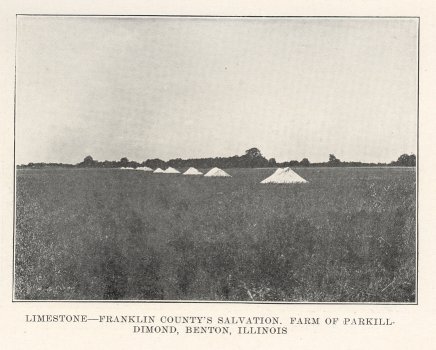
Pg 96
and some of the Summers were the charter members of this church.
The following families have been prominent in the development of the township: Shirleys, Smiths, Moss, Johnson, Bailey, Miller, Jones, Manion, Buntin, Crain, Otterson, Allen, Puckett, Chaplain, Collins, Hatchett, Creemens, Conover, Melton, Waller, Frailey, Jackson, Duckworth, Rouintree, Varnier, Harris, Minton, Randolph, Hays, Williams, Lee, Gaither, Brady and others.
The village of Aiken was started about 1875 when Aiken McLean had some of his land laid out into lots and named the town Aiken. The village has grown some, and at the present is quite a commercial point. The town has a bank and several business firms. Chas. Crisp is the leading merchant.
The township has the following schools: Bethel, Aiken, Manion, Brush Prairie, Willow Branch, Knob Prairie, Ridge, Center and Town of Aiken.
The churches are as follows: Baptist-Knob Prairie,
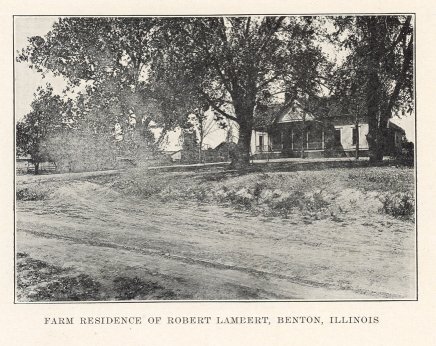
Pg 97
Bethel and Jackson Grove; Methodist-Mt. Etna; Christian- Aiken; Free Baptist-Aiken; Latter Day Saints-Johnson Grove, Carter's Chapel.
Politically, Eastern Township is Republican. The present supervisor is Wm. H. Crawford.
The township has no railroad or coal mines. The coal has been sold, with the exception of the south row of sections.
Knob Prairie is near the center of the township. It took its name from the knob in the eastern part of the prairie.
The most remarkable event in the history of the township was the enlistment of Co. F., 40th Illinois Inf. This company was largely made up around Aiken and vicinity. Aiken McLean encouraged the organization of the company. A dinner was given at his home Aug. 3, 1861, and the company left for action the same day.
Dr. John McLean, a noted physician of Chicago, is a son of Aiken McLean. Dr. McLean had a leg shot off by a cannon
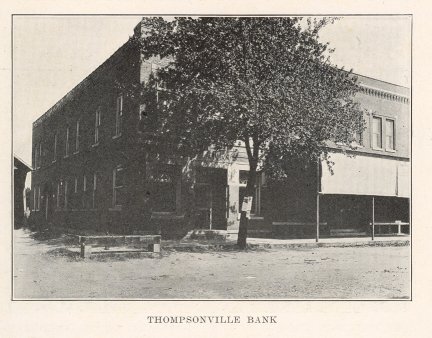
Pg 98
ball at the battle of Shiloh. Captain Shirley and Captain lng were from this locality.
Cave township lies south of Eastern and borders on Hamilton and Saline Counties.
The township took its name from a postoffice that was established about 1840, the postoffice taking its name from the postmaster-general, Cave Johnson.
In looking up the data for this sketch, the writer has been impressed not with the antiquity of our country, our state and our county, but rather with the youthfulness of it all, and the proximity of these events that so much concern us all. My grandfather, Alexander McCreery, lived until I was twenty-
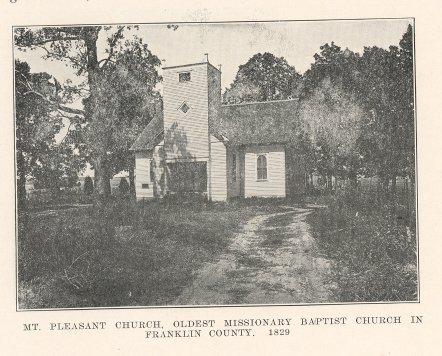
Pg 99
one years of age, and his father, John McCreery, was ten years old when the Revolutionary War began. Thus we are only three generations from the beginning of our national life.
We naturally take some community pride in being the oldest settled point in the county, and yet some of these earliest pioneers live to be known and are well remembered by some here to-day. One wonders that two or three generations should work such marvelous changes in a wild country, a virgin forest full of wild animal life and Indians.
I presume in 1804 the seven Jordan brothers, the two Brownings, Joseph E. Estes and Mr. Barbrey, were seeking a location, after leaving the last settlement at Equality, and pressing westward through the wilderness, came upon this spot, which was mostly prairie with a fine little stream of water and flowing springs with forests of white oak, hickory, walnut timber. It must have seemed a veritable paradise on earth, and was a prize worthy of the toils, the hardships and dangers of subduing.
As I understand it, these first settlers were squatters, perhaps acquiring no title to the land, but constructing a block house for protection from the Indians, subsisted on game, honey and a little corn that they might keep the Indians and game from stealing.
This block house sheltered many families within the next few years. It was probably constructed by the order of the governor in the year 1809 and stood on the south bank of the little creek about 40 rods southeast of Mr. Ing's horsebarn. Within its walls December 24th, 1810, were born to John and Nancy Browning, twin sons, William R. and James K., the first white children born in Franklin County. I can imagine that the event was properly celebrated that Christmas Tide. To demonstrate how near we are to these first events in our history, James K. Browning, one of the twins, was the father of our coroner of Franklin Co. and he is not classed with the old men either.
Pg 100
In the year 1812, while James Jordan and Mr. Barbrey were out getting wood, they were attacked by the Indians. Jordan was wounded, Barbrey was killed and scalped. My father used to point out to me the site of his grave. It was about two hundred yards a little southwest of Mr. Ing's barn, I judge.
I suppose that my grandfather bought out the interest of these settlers. It seems from the records that he entered the land in the year 1815, settling in the block house in 1816; later returning to Kentucky and marrying Ann Herrel, who was to prove a helpmate indeed, and whose mild, gentle spirit was to supply the restraining and softening influence to his rugged, positive nature.
My grandmother has told me that when they reached the Ohio River, and she had bidden good-bye to friends and relatives and was shedding tears at the parting, my grandfather said, "Never mind, Ann, you shall never regret your choice," and she declared, "I never did," though she told me
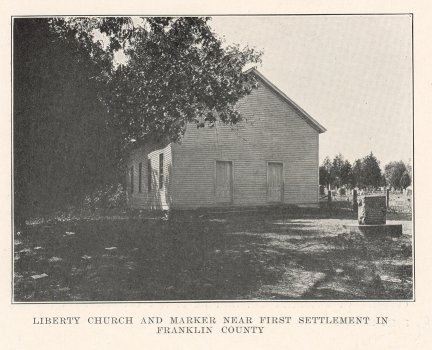
Pg 101
of occasions when my grandfather would be away until after dark, and she would slip out of the house and hide in the woods for fear of Indians, until she heard him return. The bear, the panther and the deer were abundant. I remember the story of a wild horseback ride that a woman had when a panther chased her right up to my grandfather's yard gate. Another, of my grandfather and his brother Robert, killing and piling up five bears in their yard in one day. Another, of Monroe Crawford, Uncle George and my father, when boys, finding two bucks with their horns locked, just in front of my house site. They secured an axe and some dogs and went after the deer and had one down when my grandfather rode up and shot the other. Judge Crawford became an eminent lawyer, is living at Jonesboro, and was invited to this celebration.
"Fancy Farm," the land composing the farms of Mark Stull, Lem Kimmel and Charley Willhite, was one of the noted places in the early history of our county. It seems that my great-grandfather first settled the land, later removing to Saline County to the Dunk Kincheloe farm.
Prior to the year 1821, at least, the Yost family occupied the place and they evidently brought their religion with them, for preaching services were conducted at their home at least that early, and these services led to the organization of Liberty Church, no doubt.
In the history of Franklin County the incident is told of the Rev. Braxton Parrish coming with his wife from North Carolina in 1821, and passing my grandfather's, carrying a Bible under his arm and my grandfather saying, "He had a blank sight better have a grubbing hoe on his shoulder."
Another time, Uncle Brack passed on Sunday morning on his way to Fancy Farm to preach, and caught my grandfather in the act of skinning a deer. When asked if he were going to church, he said he would be on directly, and he soon came in and after the services invited the preacher home with him for dinner.